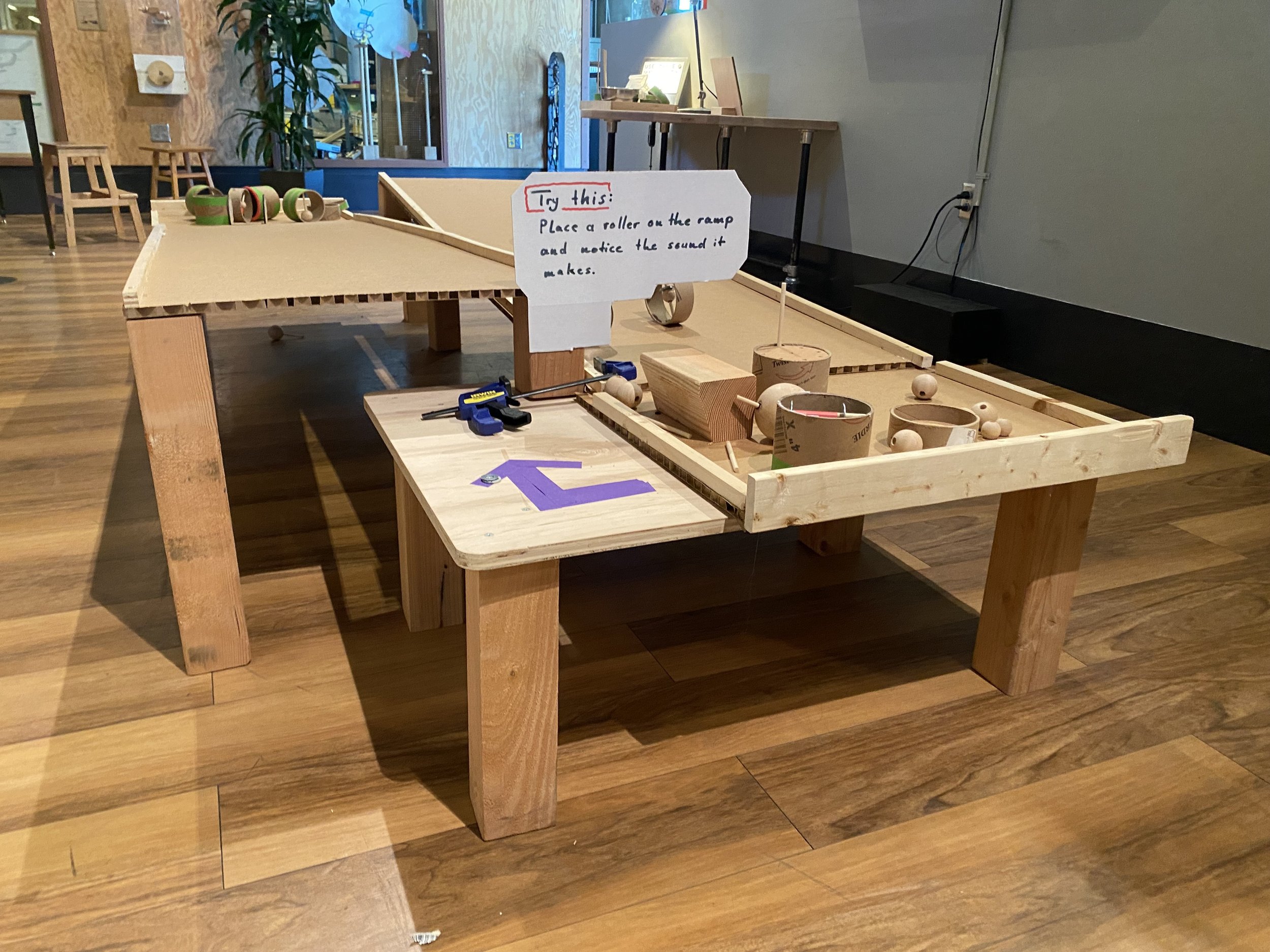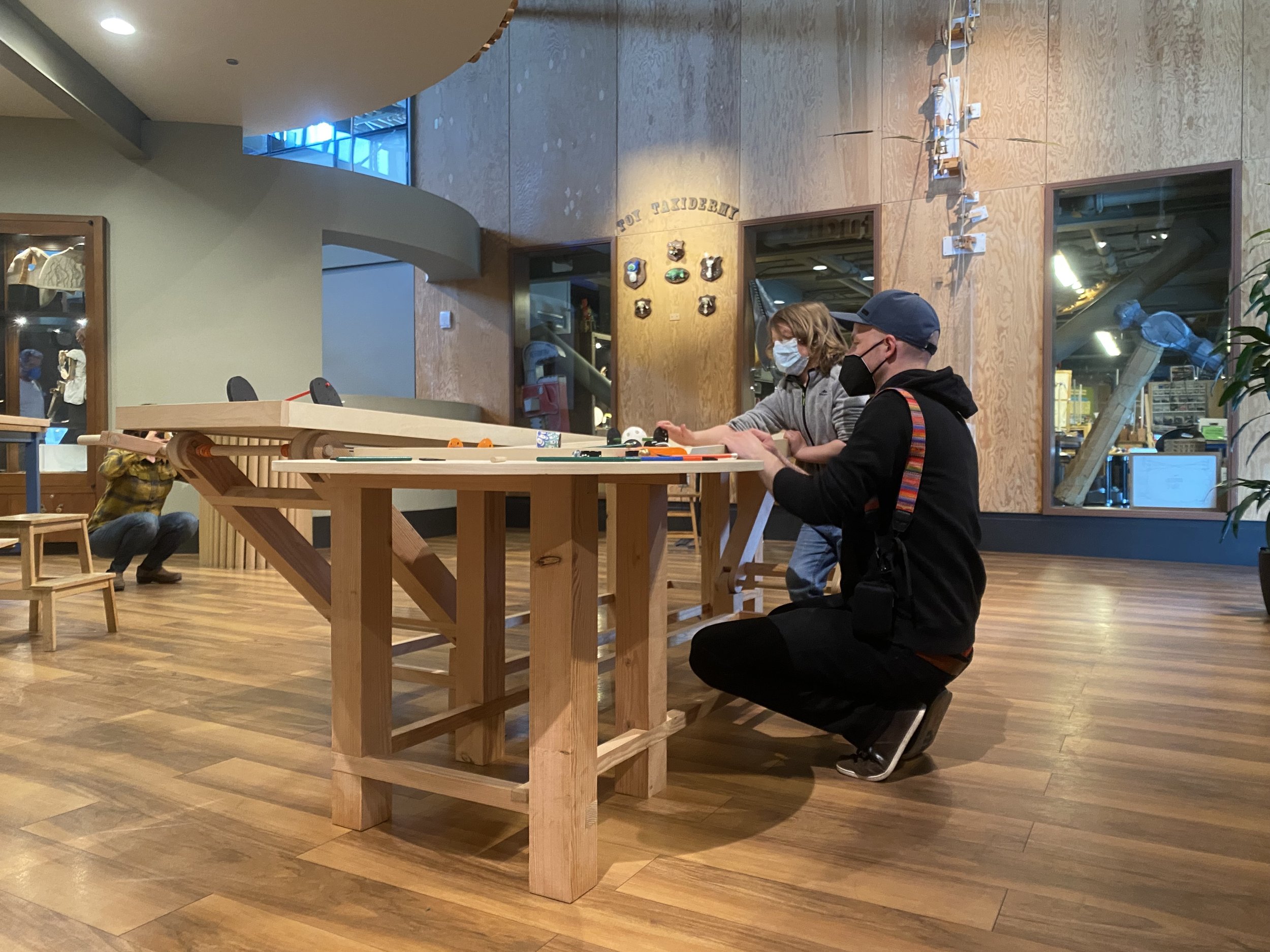Ufte Reflections and Big Ideas - Part Two
In this second part of the ‘ufte’ project wrap up, I’d like to share some thoughts about the final two ‘uftes’, unusual rollers and rhythm blocks as a way to reflect on some of the overarching themes that we’ve discovered over the course of the prototyping process with this new strand of tinkering work.
Unusual Rollers
In this ‘ufte’ activity, participants build constructions out of everyday materials that roll, scoot or wobble down a wide ramp. Learners are encouraged to observe the movements of the objects and make changes that affect the way that they travel down the surface. Our goal for this activity is to focus on the process of iterating and experimenting with phenomena like gravity, friction and balance instead of letting the outcome of making the fastest roller drive the experience.
We went through several iterations of this activity with the internal design team and conducted several prototyping sessions with visitors on the museum floor. In consultation with Shawn Hibmacronan and the exhibit development team at the Exploratorium, we designed and built a ramp set-up that will be tested throughout the summer at the Art of Tinkering exhibition. And although we’re not 100 percent finalized on our materials set, we’ve developed several key take-aways from the process that will be critical for the next steps by us and collaborators.
This activity was not on the list of ‘uftes’ that we planned to prototype when we originally developed the project. But one day during my second residency at the Exploratorium in February, Ryoko started messing around with a system of cardboard tubes, dowels and washers to make different sound-based rollers. This input inspired our entire group of educators in the Tinkering Studio to start experimenting and making our own designs with different sounds. For us, this moment sparked continued enthusiasm from the team around playing with the activity and was a sign that there was something worth following in the process of development.
To have a proof of concept for this project, we constructed a long ramp so that we (and other learners) could observe the motion of their rollers for as long as possible. We settled on an 7-8ft track. Another important development was having bumpers on the side so that while the objects could stop half way down, it would be less likely that they would fall off. We wondered where to put the materials for building and ended up deciding to have a small construction area at the end of the ramp (which also would be helpful because that’s where the materials would naturally accumulate. And finally, the last micro-innovation came from Sebastian who suggested that we have two ramps next to each other sloped in an opposite directions so that on each side there would be a starting point and an ending point. This ramp arrangement allows people to try others’ designs and makes it more likely that there will be something made by a visitor there to test when they first arrive at the ‘ufte’ environment.
A key component of any tinkering activity that we wanted to make sure to emphasize with this ‘ufte’ is the possibilities for multiple pathways through the experience. We thought that an activity with ramps and rollers could easily tip into the realm of a race (or making a car that goes the fastest). This more product focused outcome (with the possibility quantitative results) has the potential to take away the tinkerable aspects of the activity so we had to make design choices that actively encourage divergent thought, troubleshooting, collaboration and iteration.
Some of the things that we feel are important about this ‘ufte’ experience include using wheels that aren’t round/circle shapes, an emphasis in the examples on aesthetic qualities of characters or sound, and making a shallow slope for the ramp so that the unusual rolling behaviors can be appreciated. Additionally, some choices that we made to make the experience more collaborative than competitive included not having a timed release, not having a timer, not declaring a winner or a loser in the race, and having the ramp be just big enough for multiple racers to go at the same time and leaving the possibility for them to interact on the way down. Having the ramps angled opposite from each other has the additional quality of discouraging direct competition. And finally we wanted to tweak the difficulty of the experience so that it becomes a challenge just to make something that rolls and that you are proud of your creation even if it doesn’t go fast.
In addition to these design principles, we wanted to create an open ended material set that feels easy to use but allows for wide walls. We developed categories of parts that can be used in different ways including rods as axels or vertical pieces, wheels/hubs with multiple holes, many different sizes of objects, objects that work differently because of the materials qualities with regards to friction, sound and stability. Some of the directions that seem promising are wooden dowels and stiff rubber non-round wheels or sturdy hoops that could fit sound making materials inside the blank space. We also though about how to give the rollers personality in the way they move by adding things like feathers, chains or googley eyes so that even if they are made with abstract parts they can seem lazy, clumsy, proper, anxious or confused. We want to find a set of examples that encourage conversation or laughter based on how they roll down the ramp.
Some of the things that we still hope to prototype further include testing to see if it could be interesting for visitors to change the ramps by raising/lowering the slope or adding obstacles. We will test to see if those variables add to the experience or are just overwhelming. And as with all of the other ‘uftes’ there’s a lot of work to do to discover the best way to both reset the space for the next learners while recognizing and keeping track of the diversity of ideas that arise during the explorations.
Rhythm Blocks
In rhythm blocks, learners tinker with mechanisms and sound patterns both individually and in a group around a table. Participants play with adding and taking away pegs from a motorized circle which creates a regular beat or an unusual pattern. Using magnetic parts on a metallic surface keeps everything in place as you arrange the pegs to trigger mallets to strike instruments and found objects or lift cuckoo bellows. The activity makes use of loose parts (pegs, wheels, instruments) that can be arranged in an endless number of ways based on the learners' own ideas and questions.
This activity was probably the most fun to develop and in my opinion comes closest to our goals for the ufte experiences. To develop the activity we worked in close collaboration with Tom Fox of Vulpestruments who’s ideas and prototyping was crucial to the process. There were so many iterations and micro-innovations for this activity that pushed it in a direction that was intuitive, engaging, complex and collaborative.
Inspiration for the rhythm blocks activity came from a wide variety of sources along the way including the art of o-grivo, a old Exploratorium exhibit called mighty rhythm king and the musical contraptions of Wintergatan. As we reflected about these elements we developed ideas for how the set of materials could beautiful and flexible with multiple outcomes but also sturdy enough to make it on the museum floor. Some of the elements that made these parts more intuitive and robust included keeping the electronics inside the blocks, having magnetic pegs that snapped into place, making sure the set of materials looked aesthetically pleasing as well as sounded good, and limited the user interaction to something that was simple but resulted in may outcomes.
We had tried to develop sound workshops before and one of the most important things that we discovered was how much the sound quality contributes to the interaction and allows for participants to feel that they are making music together. It’s really important that the sound doesn’t feel chaotic or cacophonous but also it’s important that the ear can hear the differences based on changes. Some of the things that helped this ‘ufte’ find that balance include adding a thick rubber for mallets that allowed them to spring back and make a clear note, having blocks that allow participants to make height adjustments, , and including real instruments or instrument parts. Tom suggested to start with quieter elements as it’s easier to make things louder than make things softer which meant that we worked with softer mallets.
Once we started messing around with mechanisms and sound, there were many iterations around where the exploration centered around. Early versions used snail and triangle shaped cams to trigger the mallets. In those explorations learner’s attention was divided between making the automata like elements work and creating a satisfying rhythm. Additionally, in the beginning we focused more on hand cranks which made it harder to appreciate the different sounds created by the machines. The combination of predictable behavior with smooth quiet motors, a regular pattern of eight holes and magnetic parts and work surface along with some improvisation or randomness (the pieces are rough, the motors don’t always spin at the same speed) helped us find that balance.
One of the things that was really fun about the rhythm block ‘ufte’ is that it allows for both individual work as well as collaboration between participants. Each little system of a motor, mallet and object can be manipulated to make a repeating pattern. But after that first step it gets interesting. When there’s only one person or group working they tend to start organizing all the parts to make more and more complex soundscapes. When there are strangers working around the table, the sounds of each others rhythms tend to lead to impromptu collaboration and sharing.
There are a few more things that we’d like to go deeper on with this activity. First is having new and different types of instruments triggered by the motor blocks. Tom experimented with a stringed instrument and Sebastian made a jingle bell shaker showing just a couple of the endless possibilities. As well it would be fun to try to add a bit more customization to the parts with different sized pegs and different spacing of the holes in the spinning discs. Now that we have a solid foundation for this activity, we can begin to open things up a bit more and continue to experiment with the rhythm making ‘ufte’.
In part three of this blog post, we’ll go through some of the cross-cutting elements of all four of the uftes that we’ve been working on as a way to inform the next steps for these projects as well as identify candidates for new ‘ufte’ development work.
The LEGO Playful Learning Museum Network initiative is made possible through generous support from the LEGO Group.














